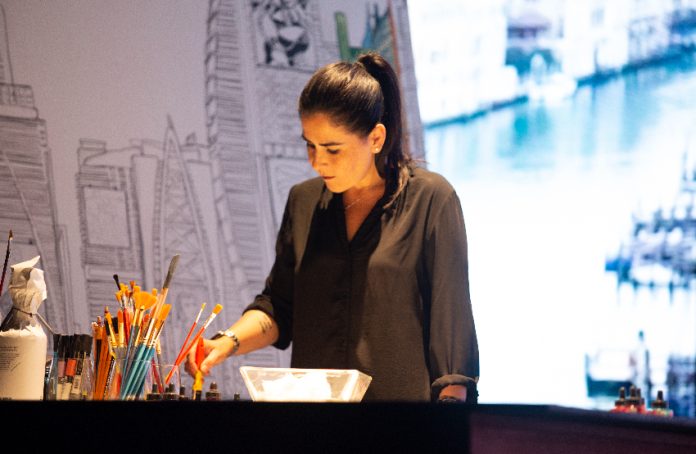Karla de Lara has been called the “mother of hyperrealist pop art”: a woman who is redefining Mexican art and strengthening US-Mexico relations as the official artist of the Bicentennial.
With over 350 individual exhibitions in more than 38 countries worldwide, including Art Basel and Art Miami, Karla de Lara has gained a reputation as a restless soul who never stops creating. Her attention to light, atmosphere, plasticity, abstract forms, and architecture enriches her paintings, which often depict cityscapes as magical colorings and reinterpretations of her own immersion, giving them a soul.
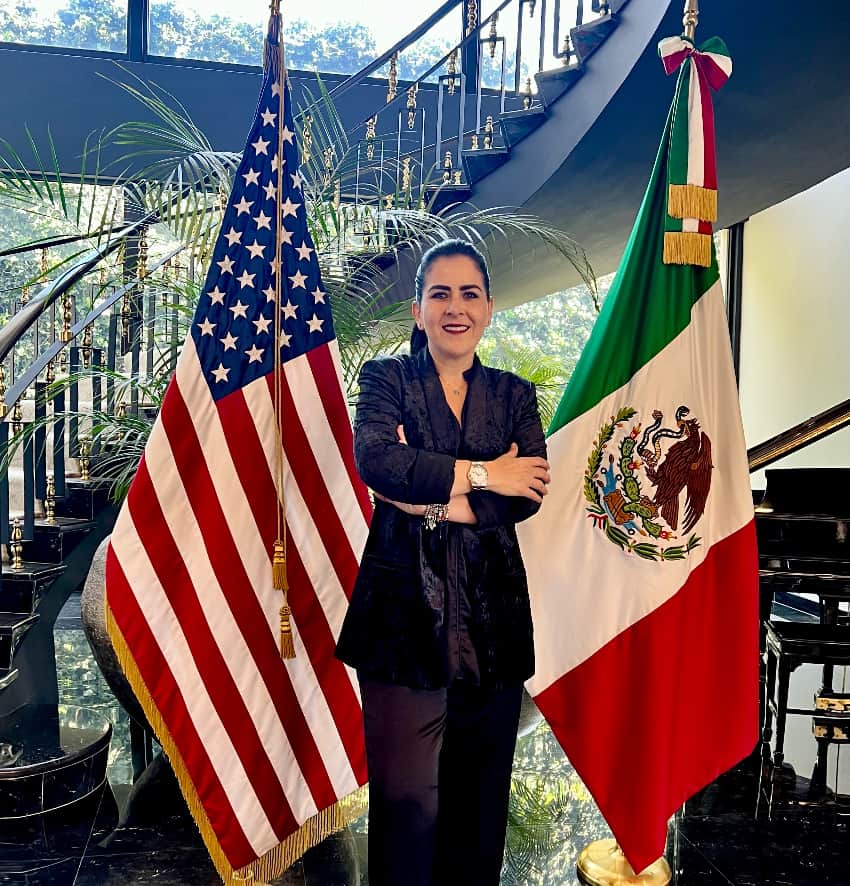
In this interview she gives insights into her artistry, family roots and her inspiring path to becoming one of Mexico’s most celebrated contemporary artists.
You were recently chosen as the official artist of the U.S.- Mexico Bicentennial. How does your artwork promote solidarity and cooperation between the two countries?
I was honored when the Mexican government and then the U.S. representatives asked me to be the artist for their bicentennial celebration. It’s been fascinating learning about the relationship between Mexico and the United States. As a neighboring country, we have many Mexican citizens who have become U.S. citizens, creating bi-cultural families. However, some third-generation Americans don’t feel connected to Mexico, many of them don’t even speak Spanish. So, they’re in between two cultures, not truly identifying with either.
To help with this issue, I’ve been working on creating a sense of harmony between the two countries and helping them navigate this new identity. It’s not exactly a new nationality, but a mix between the two. It’s similar to when the Spanish conquered Mexico. It wasn’t the Mexico we know now. It started with the native peoples from different cultures such as the Aztecs, Mayans, and Olmecs and they mixed with the Spanish to create this new breed: Mexicans. We’re neither native nor Spanish and it’s this fusion that made the Mexican nation.
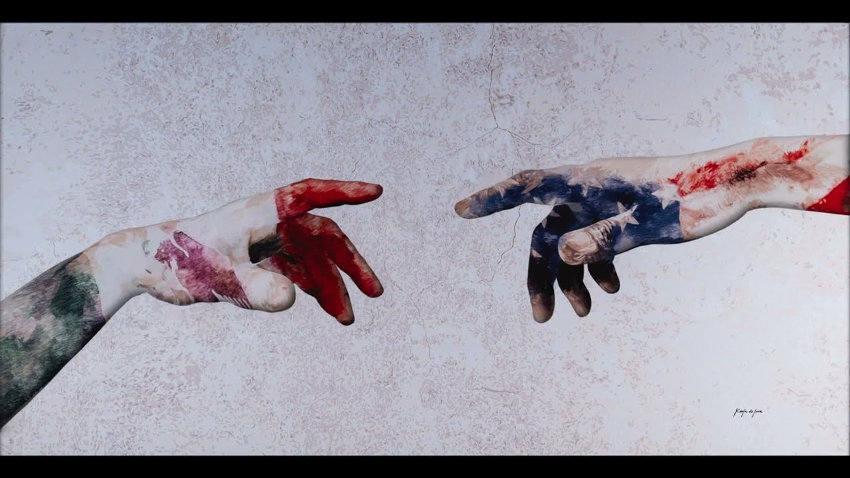
When I began working on the artwork for the U.S.-Mexico Bicentennial, I found inspiration in Michelangelo’s “The Creation of Adam.” Specifically, I was struck by the representation of the first minute of humanity, and I wanted to translate that idea into the first minute of the bicentennial – the start of the relationship between our two countries.
That’s why I decided to tattoo the Mexican and American flag on the arms of two hands, symbolizing a connection between the two nations. To take it a step further, Juan Carlos and his team created a powerful NFT where the hands touch, forming the universal symbol of respect, love, and peace.
In many countries around the world, this symbol is associated with a message of unity and togetherness, which is exactly what we wanted to convey through our artwork. As neighbors and allies, it’s important that we are open to helping each other. When we work together, we can achieve great things and foster a positive relationship between our two nations.
I’ve also created several important pieces of art that showcase the blending of our cultures. For example, I painted Times Square with many Mexican symbols, and I painted one of Mexico’s most iconic buildings, the Palacio de Bellas Artes, with a backdrop of Mount Rushmore and an American bald eagle. These pieces of art are meant to communicate the mutual respect and connection between the two countries.
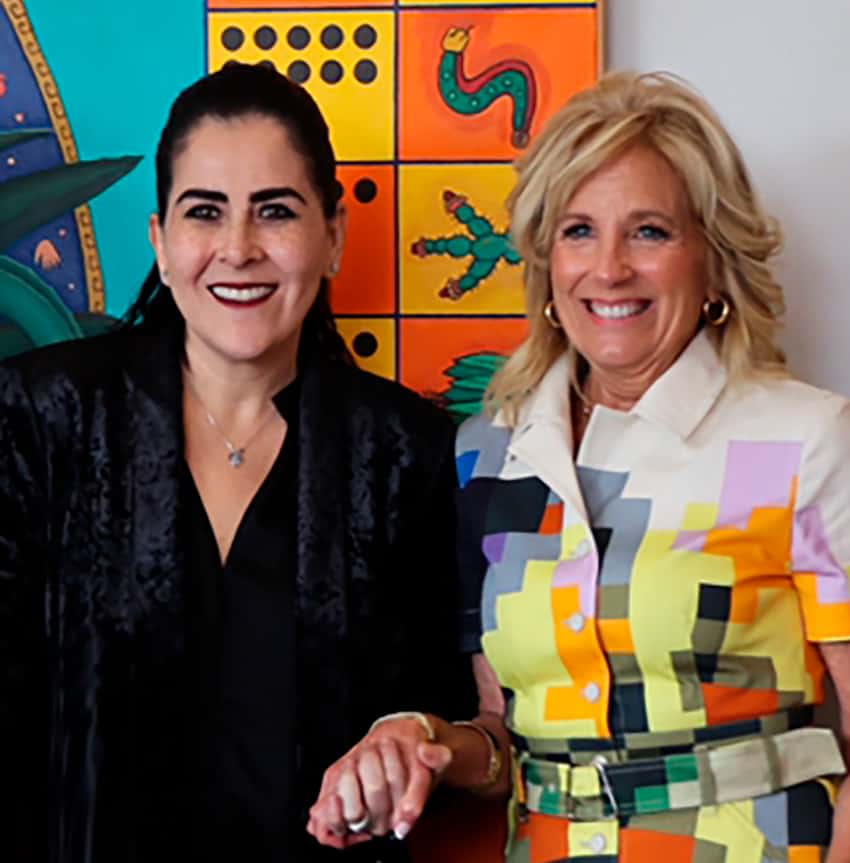
You gave your first masterclass at the Belmond Sierra Nevada Hotel in San Miguel de Allende recently. How does it feel to teach your art to others?
I really enjoy it! They’re all very talented and it’s amazing to see how quickly they learn. But since this is my first time teaching a class it’s a bit challenging. I never really wanted to do it before because I have my own unique technique that I developed over time without any strict rules. But I realized that I could share some of my ideas with others and help them develop their own artistic style and unique cultural interpretation using the same technique.
Teaching is a learning process for me too, as my technique is always evolving and improving. I’m excited to see what my students will create and how I can continue to develop my own skills through this experience.
What advice would you give to up and coming artists?
First of all, make sure that this is really what you want to do. It’s not just a hobby or a fleeting passion, but a long-term career that requires dedication and hard work. I know it can be tough, and sometimes it feels like you’re not making progress, but don’t give up
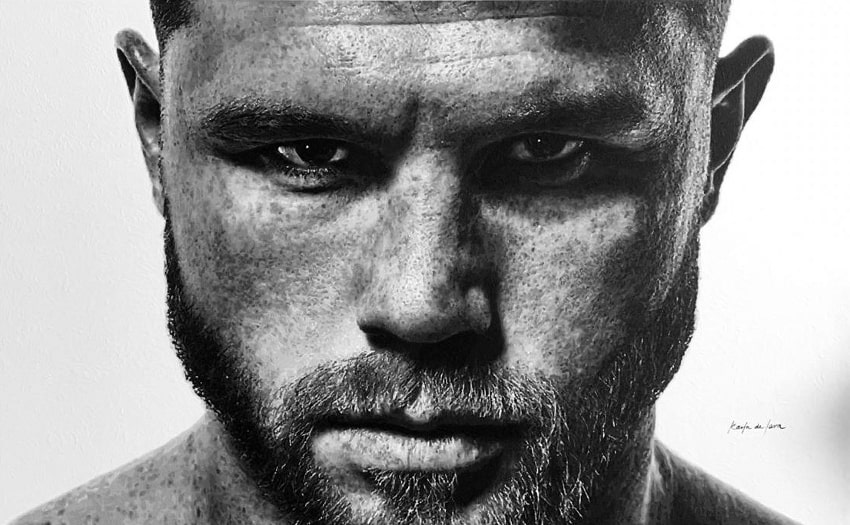
Keep working at it, and over time you’ll see your creations take shape. Remember that success is not just about talent, but also about discipline and perseverance.
Have you always been artistic, even from a young age?
Yes, painting has been a part of my life for as long as I can remember. I started when I was just four years old, and from there, my parents always encouraged me to explore my creative side. I took advantage of every class available to me, which allowed me to learn a variety of techniques.
When it came time to decide on a career path, I chose to study graphic design in college, followed by industrial design. However, even though I loved these fields, I never really saw myself as an artist. It wasn’t until later in life that I realized how much painting meant to me. Perhaps this was because I never had any artists in my family, and I didn’t know anyone who pursued art as a profession.
Your works have been exhibited in hundreds of galleries and museums around the world. How has this exposure to other cultures and countries affected your career as an artist?
I’ve always been an adventurer at heart, so after college, I decided to travel around Europe for several months. I fell in love with the beautiful city of Florence; a friend of mine was living there and suggested that I stay and find something to study. At first, I thought it was a crazy idea. I mean, what could I possibly study in a foreign country where I didn’t even speak the language? But the idea stuck with me, and I found out that Florence University was offering scholarships to foreigners. I couldn’t believe my luck when I saw that one of the courses on offer was plastic arts. It felt like a sign that this was meant to be.
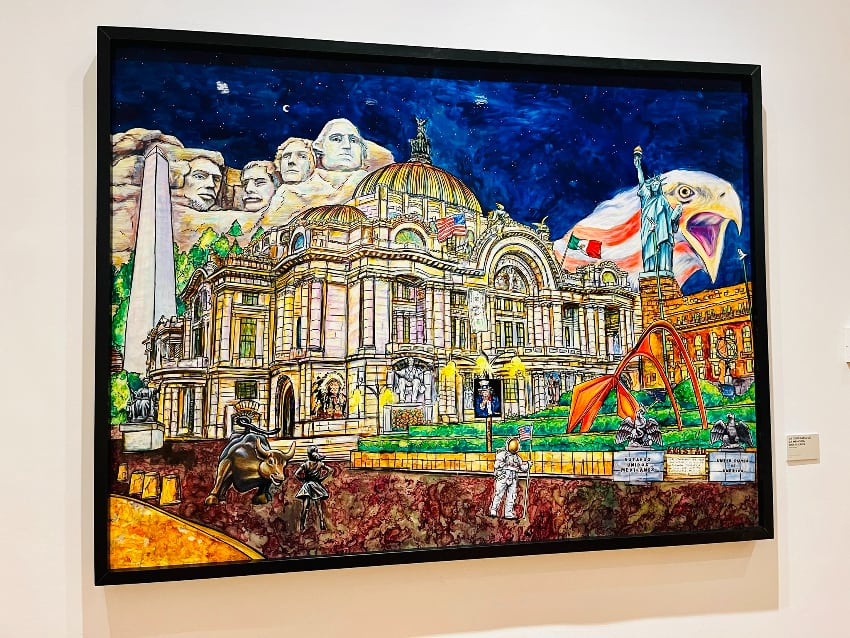
I decided to take a chance and apply for the scholarship. I was nervous about the test, I was accepted to study there for three years. It was absolutely amazing. I took art history classes in the museum and lived and breathed art during my time in Florence. It was an incredibly inspiring experience that helped shape my passion for art and my appreciation for other cultures.
When you moved back to Mexico, is that when you decided to dedicate your life to your art?
Not entirely. Actually, when I returned to Mexico, I went back to doing the same thing as before. I had a design studio and a publicity agency, which was also making films. Around that time I met my husband, Juan Carlos, who also had a publicity agency and we started a family.
But after running my own design and publicity business for some time, I started to feel a bit burnt out. I was spending most of my time selling instead of designing, and I craved more time to be creative. That’s when I turned to my husband and asked him if he would support me if I pursued painting full-time. He fully backed my decision, which gave me the confidence to take a leap into the unknown.
What was the transition like from corporate work to full-time artist?
It was tough! At the beginning of my career as a full-time artist and a client of Juan Carlos’ agency, he advised me to develop a very personal and unique style that people could recognize immediately, just like other successful artists in our industry. But I found it challenging to repeat myself over and over again and put myself in a box that limited my curiosity for experimentation.Although Juan Carlos meant well, it made me crazy and I felt like I was losing my creative freedom.
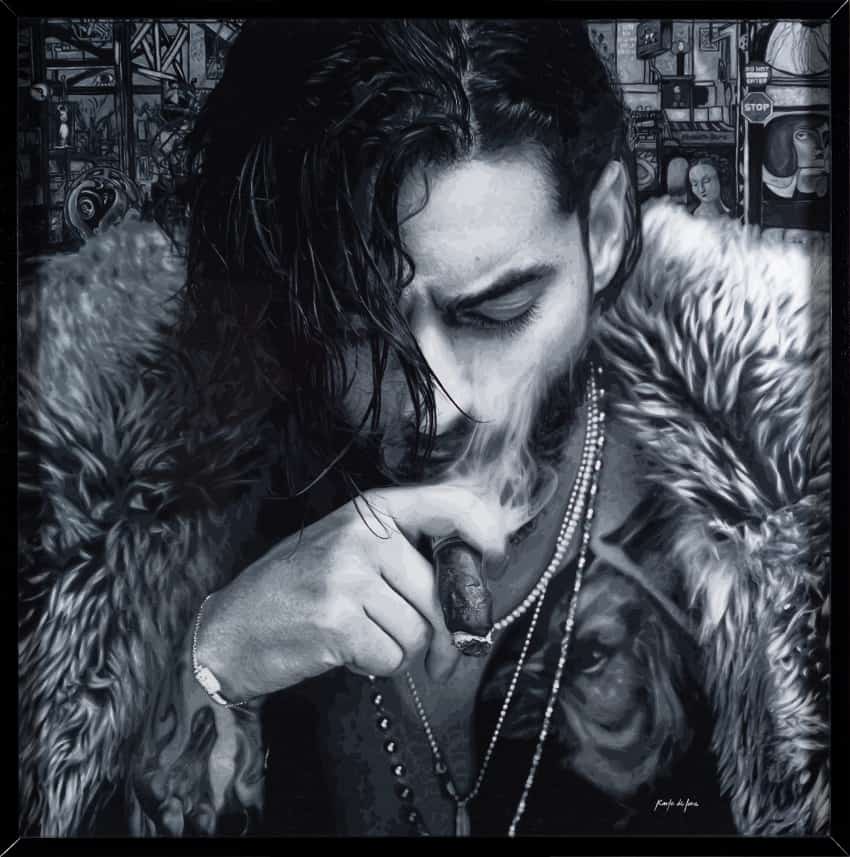
So, I decided to take a different path and started exploring my own expression. I felt that I needed to do things that enriched my creative side and allowed me to be more experimental. I told Juan Carlos this, and with time, people started recognizing my style even though I might have produced two completely opposite pieces of art. I realized that being true to myself was the best way to develop my art and that I could still be recognizable without limiting my creativity.
What was it like when your full-time art career started to take off?
It was a difficult road, and there were moments when I wasn’t sure if I could keep going. My career was becoming really demanding, and at one point, Juan Carlos had to choose between continuing to work with his agency or representing me. It was a tough decision, especially since we already had a small son and wouldn’t receive a regular income if he chose to support me.
The first couple of years were really trying, and there were times when we thought about giving up. We couldn’t afford to pay our son’s tuition fees, we had to sell our cars and we were months behind on rent. There were even times when Juan Carlos asked if it was time to quit. But I knew I couldn’t give up, not after all we’d been through. So, I asked him to have faith and give me one more year, and within that year, we started to see the light. It wasn’t easy, but it was all worth it.
Can you share your experiences as a female artist in a male-dominated industry and how you have navigated any challenges or resistance?
As a woman artist, I can say that at times it’s been harder to gain recognition and respect for my work. We live in a society that’s still rooted in gender inequality, and that often means that our voices are drowned out or overlooked. But things are changing, and I’m glad to see more and more women artists getting the recognition they deserve.
I’ve been lucky to have the support of my partner, Juan Carlos, who’s always been open-minded and supportive of my career. I’ve never had to choose between my family and my passion for art. It’s important to remember that we’re all in this together, and by supporting each other and speaking out, we can create a world where women’s voices are heard and celebrated.
How do you feel about your children following in your footsteps in the art world?
I’m proud of them. Maybe it’s in their blood, or maybe they were inspired by watching me paint when they were growing up. My oldest son is already pursuing a career in the art world, and I couldn’t be more thrilled for him. My youngest has also had a few exhibitions, and while I’m not sure if they’ll ultimately pursue a career in the arts, my partner Juan Carlos and I believe that it’s important to support our children’s talents and give them the space, encouragement, and freedom to grow.
As parents, it’s our job to help our children find their passions and pursue their dreams, whatever they may be but also know that nothing is given to you, you must work hard to get it. We always remind our kids of the hardships we have faced in pursuit of our passion.
Can you give us some clues about what’s next? You’ve recently been working on some NFT’s. How do you balance the use of technology and physical creation?
Yes, the world is moving towards digital art, and I believe it’s important for us to keep up with the trends. But, I also strongly feel that the value of physical art and creating with my hands will never diminish. In fact, I think it will become even more valuable in a world where everything can be replicated digitally.
This summer, Karla de Lara’s bicentennial commemorative paintings will be exhibited at the White House at the direct invitation of the First Lady of the United States, Jill Biden. She’ll also be touring in China and Dubai later this year.
